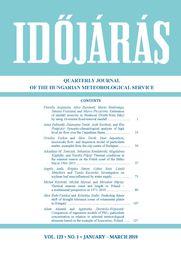IDŐJÁRÁS - angol nyelvű folyóirat
Vol. 123, No. 1 * Pages 1–133 * January - March 2019
 |
|
 letöltés [pdf: 3704 KB]
letöltés [pdf: 3704 KB]
Estimation of rainfall erosivity in Piedmont (Northwestern Italy) by using 10-minute fixed-interval rainfall data
Fiorella Acquaotta, Alice Baronetti, Mario Bentivenga, Simona Fratianni, and Marco Piccarreta
DOI:10.28974/idojaras.2019.1.1 (p. 1–)
Fiorella Acquaotta, Alice Baronetti, Mario Bentivenga, Simona Fratianni, and Marco Piccarreta
DOI:10.28974/idojaras.2019.1.1 (p. 1–)
Synoptic-climatological analysis of high level air flow over the Carpathian Basin
Anna Zsilinszki, Zsuzsanna Dezső, Judit Bartholy, and Rita Pongrácz
DOI:10.28974/idojaras.2019.1.2 (p. 19–)
Anna Zsilinszki, Zsuzsanna Dezső, Judit Bartholy, and Rita Pongrácz
DOI:10.28974/idojaras.2019.1.2 (p. 19–)
Dust deposition, microscale flow- and dispersion model of particulate matter, examples from the city center of Budapest
Orsolya Farkas and Ákos Török
DOI:10.28974/idojaras.2019.1.3 (p. 39–)
Orsolya Farkas and Ákos Török
DOI:10.28974/idojaras.2019.1.3 (p. 39–)
Thermal conditions in the summer season on the Polish coast of the Baltic Sea in 1966 –2015
Arkadiusz M. Tomczyk, Sebastian Kendzierski, Magdalena Kugiejko, and Natalia Pilguj
DOI:10.28974/idojaras.2019.1.4 (p. 57–)
Arkadiusz M. Tomczyk, Sebastian Kendzierski, Magdalena Kugiejko, and Natalia Pilguj
DOI:10.28974/idojaras.2019.1.4 (p. 57–)
Investigation of soybean leaf area influenced by water supply
Angela Anda*, Brigitta Simon, Gábor Soós, László Menyhárt, and Tamás Kucserka
DOI:10.28974/idojaras.2019.1.5 (p. 73–)
Angela Anda*, Brigitta Simon, Gábor Soós, László Menyhárt, and Tamás Kucserka
DOI:10.28974/idojaras.2019.1.5 (p. 73–)
Thermal seasons onset and length in Poland – a multiannual perspective on 1971–2010
Michał Kitowski, Michał Marosz, and Mirosław Miętus
DOI:10.28974/idojaras.2019.1.6 (p. 89–)
Michał Kitowski, Michał Marosz, and Mirosław Miętus
DOI:10.28974/idojaras.2019.1.6 (p. 89–)
Predicting future shift of drought tolerance zones of ornamental plants in Hungary
Ákos Bede-Fazekas and Krisztina Szabó
DOI:10.28974/idojaras.2019.1.7 (p. 107–)
Ákos Bede-Fazekas and Krisztina Szabó
DOI:10.28974/idojaras.2019.1.7 (p. 107–)
Comparison of regression models of PM10 particulate concentration in relation to selected meteorological elements based on the example of Sosnowiec, Poland
Adam Adamek and Agnieszka Ziernicka-Wojtaszek
DOI:10.28974/idojaras.2019.1.8 (p. 127–)
Adam Adamek and Agnieszka Ziernicka-Wojtaszek
DOI:10.28974/idojaras.2019.1.8 (p. 127–)
IDŐJÁRÁS folyóirat

Az IDŐJÁRÁS a HungaroMet Nonprofit Zrt. negyedévenként megjelenő angol nyelvű folyóirata
Megrendelhető a journal.idojaras@met.hu címen.
A szerzőknek szánt útmutató itt olvasható.
Megrendelhető a journal.idojaras@met.hu címen.
A szerzőknek szánt útmutató itt olvasható.









